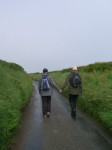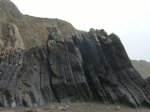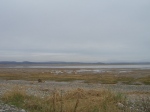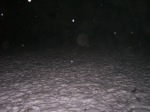I am walking with Greg and Lalitha. I have known Greg since I was an undergraduate student (he was also my PhD supervisor). I have known Lalitha, now Greg’s wife, from when we were postgraduates together.
My 10th walk is the first one to take me up a Munro – Beinn An Dothaidh (Hill of the Scorching). Sitting on the edge of Rannoch Moor, it rises to 3293 feet. Greg walked this hill some 15 years ago, passing through and then looking down upon thick fog and cloud (which eventually evaporated). Today, it’s hot and sunny and I coat myself in Factor 50.
We begin our walk at the Bridge of Orchy train station and the route is well marked by a path that leads up the coire. At the start, a cheerful greeting made out of white stones laid on the ground welcomes us: ‘Hallo’, with a stone arrow helpfully pointing north (up the hill). The going is a steady ascent for the first section, not overly strenuous. It eases my legs and lungs into the concept of hill walking, warming them up, getting them into a rhythm. (Though I walk a lot, I do not walk up a lot of hills.) Looking back down the route just covered, even from here the view is something to behold, as the landscape opens up.
The ground is so dry in places it almost resembles sand. There are scatterings of wild mountain flowers, summery yellow and striking purple. The path gleams as the sun hits the surfaces of some of stones that seem almost metallic. Singular, huge boulders, presumably abandoned in the glacier melt, stud the hill side. Stopping for a rest and a snack, we enjoy the scene below, looking out across to Loch Tulle, my binoculars bringing the impressive Black Mount Lodge close.
Though there’s a sort of accepted etiquette to walking (saying hello to the people passing in the other direction), hill walking magnifies it for the passing is often an overtaking, as faster walkers stride ahead. But then at some point, they will stop for a rest, and you will in turn pass by them. And so this swapping of places will continue all the way up and down, forging a sort of camaraderie and temporary community of fellow walkers. Faces will become familiar, walking styles observable (look at the speed, look at the sure-footedness…)
As we walk further into the coire, a burn to our left cascades enticingly. Oh, to dip these hot feet into that cool water. At one point we cross it, and splash our faces, a momentary reprieve. During their ‘courtship’ Greg used to recite poetry to Lalitha when they walked in the hills. I’m impressed by that romantic gesture, though not surprised that Greg is a Romantic (he admits to bringing books of poetry with him on his walks; Walt Whitman was a favourite).
Soon, the Coire an Dothaidh becomes much steeper, and zig zagging, with high steps that make my thighs strain and my pulse race. The scree surface is pretty precarious in places, and even with the thankful loan of a walking pole, I find myself scrambling a bit. Finally, puffed, we’re at the top of the coire, the bealach, which is marked by a cairn. We have our lunch here, flanked on both sides (Beinn An Dothaidh on our left, and Beinn Dorain on our right), with a stunning view down to Loch Lyon. Though Beinn Dorain means Mountain of the Otter, Lalitha spots a huge hare, belting down Dothaidh and disappearing out of view up Dorain. Its winter coat still looks pretty intact. Patches of snow remain visible on the hill side.
This is not the summit of our walk though, just a temporary resting place. From here, the visible path continues fairly steeply up Dothaidh before petering out as the land turns boggy. The bogs provide perfect conditions for strikingly colourful mosses. One moss is almost black, as if charred. We head towards the ridge, on the way encountering a solid slab of snow, still more than a foot deep. (One can only imagine how deep it must have been in the winter.) It is creating its own wee stream of water, as the sun beats down on it. We dig into it, taking handfuls of mountain ice cream (totally low fat). The snow tastes startlingly cool, refreshing us for the last haul up the side of the hill. The grass here is dried out and yellowing (which explains the name of this mountain).
Heading towards what Greg believes is the summit, I’m concerned as I can’t see a cairn marking it – could it be another trick of perspective? But reaching it, I find that I am, indeed, on top of the mountain. And on top the world. Standing on the plateau, we have a 360 degree vista. Though it’s a bit hazy, the view is breathtaking. In front of me, Rannoch Moor opens out, and mountain range after mountain range unfolds, all the way to Ben Nevis. It’s a view to soak up, to dwell on, to marvel at. This is why people climb hills. From up here, the hard effort makes full sense. ‘You can see why summits are known as the armchairs of the Gods’, says Greg.
It’s taken us four hours to get up here but it will take only two to walk back down. My ankles will begin to feel the pressure, Lalitha’s knees will throb, but we will be spurred on by the thought of a cool drink at the Orchy Hotel. Tomorrow, my legs will ache, a pleasant reminder of the heights they have carried me, of the priceless gift that walking (and friends) can deliver.





























